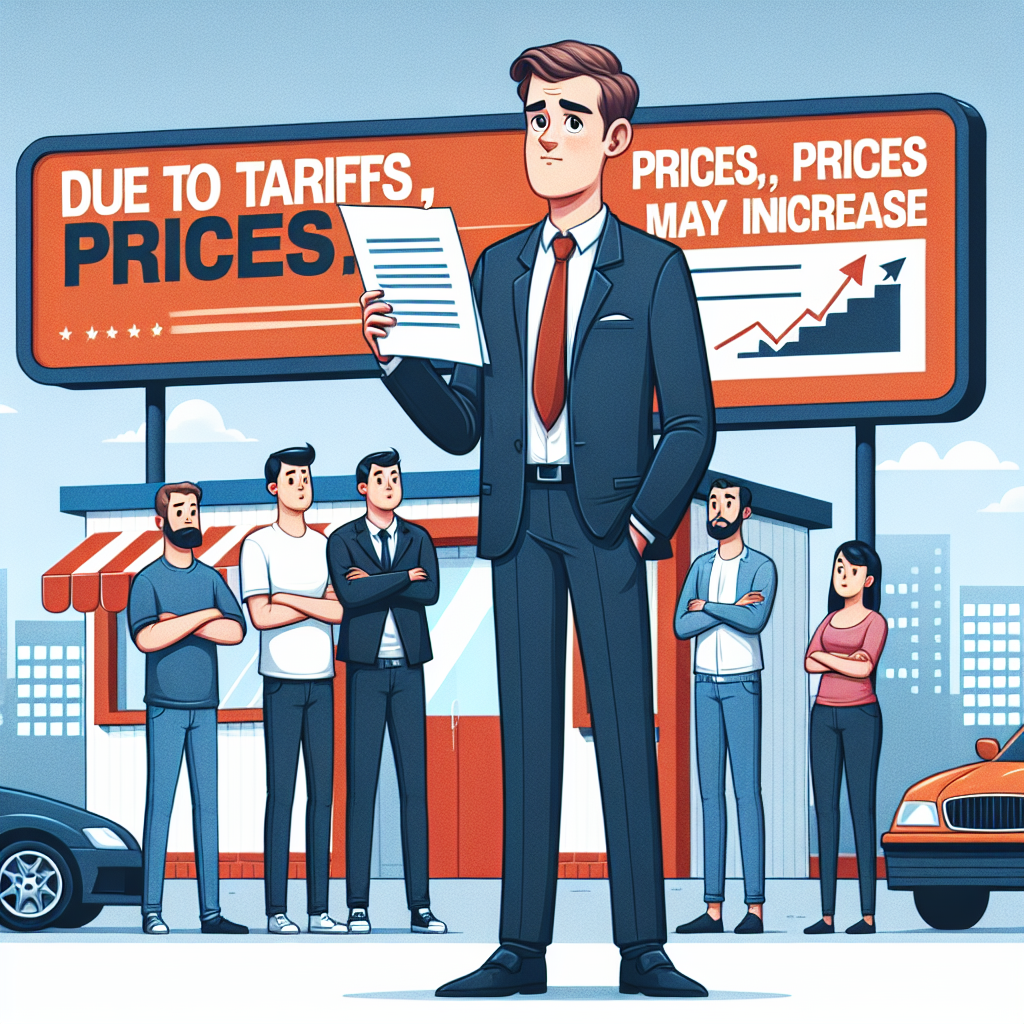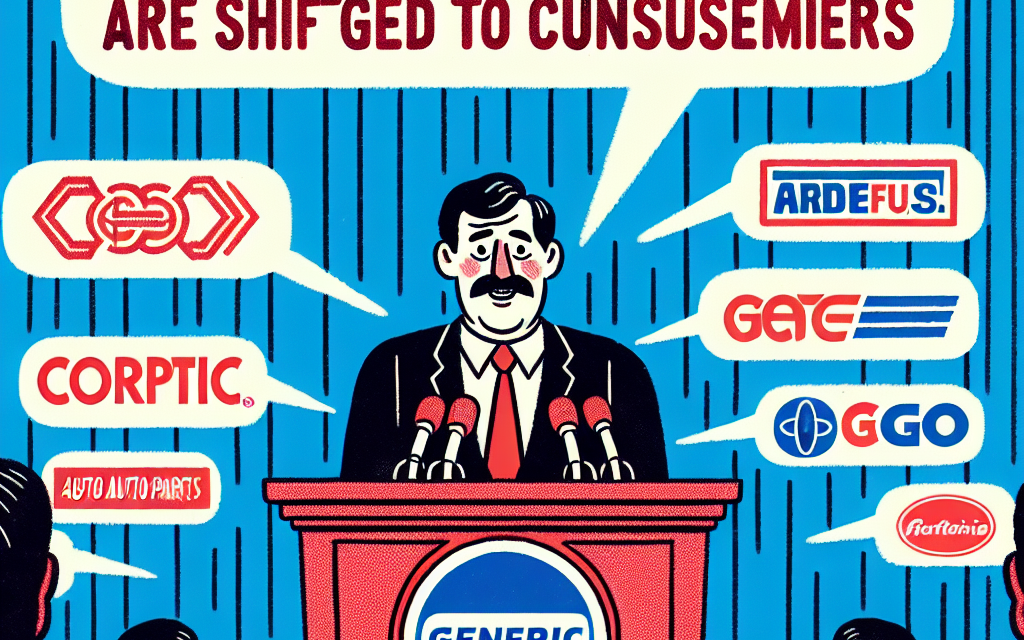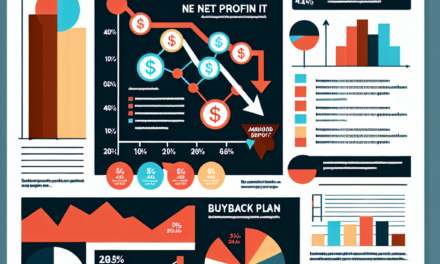“Tariff Tides: Consumers Bear the Brunt as AutoZone and Others Pass on Costs”
Introduction
In a recent development that underscores the ongoing impact of international trade policies on domestic markets, AutoZone’s CEO has confirmed that the company will be passing the costs associated with tariffs onto consumers. This strategic decision highlights a broader trend among corporations as they navigate the financial pressures imposed by tariffs on imported goods. As AutoZone, a leading retailer in automotive parts and accessories, adjusts its pricing strategy, other companies across various industries are also adopting similar measures. This shift reflects a growing consensus in the business community on how to manage the increased costs resulting from trade tariffs, ultimately affecting consumer prices and market dynamics.
Impact Of Tariff Costs On AutoZone’s Pricing Strategy
In recent developments, AutoZone, a leading retailer in the automotive parts industry, has confirmed that the costs associated with tariffs have been transferred to consumers. This revelation comes amidst a broader trend where companies across various sectors are adopting similar strategies to mitigate the financial impact of tariffs. The decision by AutoZone’s leadership underscores the complex dynamics of global trade policies and their direct influence on consumer pricing strategies.
The imposition of tariffs, particularly those affecting goods imported from key manufacturing hubs, has created a ripple effect throughout the supply chain. For AutoZone, which relies heavily on a diverse range of imported automotive parts and accessories, the increased costs have necessitated a reevaluation of their pricing strategy. By passing these costs onto consumers, AutoZone aims to maintain its financial stability and shareholder value in a challenging economic environment. This approach, while pragmatic from a business perspective, raises questions about consumer purchasing power and market competitiveness.
Transitioning to the broader industry context, AutoZone’s strategy is not an isolated case. Many companies facing similar tariff-induced cost pressures have opted to adjust their pricing models accordingly. This trend highlights a significant shift in how businesses are navigating the complexities of international trade regulations. By transferring costs to consumers, companies can safeguard their profit margins, albeit at the risk of alienating price-sensitive customers. This delicate balance between maintaining profitability and ensuring customer satisfaction is a critical consideration for businesses operating in today’s globalized economy.
Moreover, the decision to pass tariff costs onto consumers reflects a broader economic reality where businesses are compelled to adapt to external pressures. As tariffs continue to influence the cost structures of various industries, companies are increasingly prioritizing strategies that ensure long-term sustainability. For AutoZone, this means not only adjusting prices but also exploring ways to optimize their supply chain and enhance operational efficiencies. By doing so, they aim to mitigate the impact of tariffs while remaining competitive in a rapidly evolving market landscape.
In addition to the immediate financial implications, the shift in pricing strategy also has potential long-term effects on consumer behavior. As prices for automotive parts and accessories rise, consumers may become more discerning in their purchasing decisions, potentially seeking alternative suppliers or delaying non-essential purchases. This shift in consumer behavior could, in turn, prompt companies like AutoZone to innovate and differentiate their offerings to retain customer loyalty.
Furthermore, the broader economic implications of this trend cannot be overlooked. As more companies follow AutoZone’s lead in passing tariff costs onto consumers, there is a potential for inflationary pressures to build within the economy. This scenario could lead to increased scrutiny from policymakers and regulators, who may seek to address the underlying causes of such price adjustments.
In conclusion, AutoZone’s confirmation of shifting tariff costs to consumers is emblematic of a wider industry trend driven by the complexities of global trade policies. While this strategy helps companies like AutoZone maintain financial stability, it also poses challenges in terms of consumer affordability and market dynamics. As businesses continue to navigate these challenges, the interplay between tariff costs, pricing strategies, and consumer behavior will remain a critical area of focus for industry leaders and policymakers alike.
How Tariff Shifts Affect Consumer Spending In The Auto Parts Industry
In recent developments within the auto parts industry, AutoZone’s CEO has confirmed that the costs associated with tariffs are being passed on to consumers, a strategy that is increasingly being adopted by other companies in the sector. This shift in cost burden is a direct response to the ongoing trade tensions and the imposition of tariffs on imported goods, which have significantly impacted the pricing strategies of businesses reliant on global supply chains. As these tariffs increase the cost of imported auto parts, companies are left with limited options: absorb the additional expenses, reduce profit margins, or transfer the costs to consumers. The latter has become the prevalent choice, as maintaining profitability remains a priority for these businesses.
The decision to pass tariff costs onto consumers has far-reaching implications for consumer spending within the auto parts industry. As prices for essential components rise, consumers are faced with higher expenses for vehicle maintenance and repairs. This increase in costs can lead to a reduction in discretionary spending, as individuals allocate more of their budgets to cover necessary auto-related expenses. Consequently, this shift can have a ripple effect on the broader economy, as reduced consumer spending in other areas can slow economic growth.
Moreover, the impact of these tariff-induced price increases is not uniform across all consumer segments. Lower-income individuals, who may already be struggling to manage their finances, are disproportionately affected by rising auto parts costs. For these consumers, the increased financial burden can lead to deferred vehicle maintenance, which may result in more significant repair costs in the long run. This situation underscores the importance of understanding the broader socioeconomic implications of tariff policies and their effects on consumer behavior.
In addition to affecting individual consumers, the shift in tariff costs also influences the competitive landscape within the auto parts industry. Companies that can efficiently manage their supply chains and minimize cost increases may gain a competitive advantage over those that are less adept at navigating these challenges. This dynamic can lead to market consolidation, as smaller or less efficient companies struggle to compete with larger, more resourceful players. As a result, consumers may face reduced choices and potentially higher prices in the long term.
Furthermore, the decision to pass tariff costs onto consumers highlights the interconnectedness of global trade and domestic markets. As companies adjust their pricing strategies in response to international trade policies, the effects are felt by consumers at the local level. This interconnectedness underscores the importance of considering the broader implications of trade policies and their potential impact on domestic industries and consumer welfare.
In conclusion, the confirmation by AutoZone’s CEO that tariff costs are being shifted to consumers reflects a broader trend within the auto parts industry. As companies grapple with the financial pressures of tariffs, the decision to pass these costs onto consumers has significant implications for consumer spending and the overall economic landscape. By understanding these dynamics, policymakers and industry stakeholders can better navigate the challenges posed by trade tensions and work towards solutions that minimize the adverse effects on consumers and the economy. As the situation continues to evolve, it remains crucial to monitor these developments and their impact on both the industry and consumers alike.
AutoZone’s Response To Tariff Costs: A Case Study
In recent developments within the automotive retail industry, AutoZone’s CEO has confirmed that the company has shifted the burden of increased tariff costs onto consumers. This decision, while not unique to AutoZone, highlights a broader trend among companies facing similar economic pressures. As tariffs on imported goods have risen, businesses across various sectors have been grappling with how to manage these additional expenses. AutoZone’s approach provides a case study in how companies are navigating these challenges and the implications for consumers.
AutoZone, a leading retailer of automotive parts and accessories, has been significantly impacted by tariffs imposed on goods imported from key manufacturing regions. These tariffs have increased the cost of raw materials and finished products, thereby squeezing profit margins. In response, AutoZone has opted to pass these costs onto consumers through higher prices. This strategy, while ensuring the company’s financial stability, raises questions about consumer behavior and market dynamics in the face of rising prices.
The decision to shift tariff costs to consumers is not isolated to AutoZone. Many companies in the automotive sector and beyond are adopting similar strategies. This trend underscores a critical aspect of business operations: the need to maintain profitability in a competitive market. By increasing prices, companies aim to offset the financial strain caused by tariffs, thereby safeguarding their bottom line. However, this approach also necessitates a careful consideration of consumer response, as higher prices could potentially lead to reduced demand.
Transitioning to the broader economic landscape, the impact of tariffs extends beyond individual companies. As more businesses pass on these costs to consumers, the cumulative effect could contribute to inflationary pressures. This scenario presents a challenge for policymakers, who must balance trade policies with the potential economic repercussions. Moreover, consumers, already facing various financial pressures, may need to adjust their spending habits in response to rising prices across multiple sectors.
In examining AutoZone’s strategy, it is essential to consider the company’s position within the automotive retail industry. As a major player, AutoZone’s pricing decisions can influence market trends and competitive dynamics. By setting a precedent for passing on tariff costs, AutoZone may encourage other companies to adopt similar strategies, thereby reinforcing the trend. This collective shift could reshape the competitive landscape, as companies vie to maintain market share while managing increased costs.
Furthermore, AutoZone’s response to tariff costs highlights the importance of strategic decision-making in times of economic uncertainty. Companies must weigh the immediate benefits of passing costs onto consumers against the potential long-term implications for brand loyalty and customer satisfaction. In this context, AutoZone’s approach serves as a valuable case study for other businesses navigating similar challenges.
In conclusion, AutoZone’s decision to shift tariff costs to consumers reflects a broader trend among companies facing increased economic pressures. This strategy, while ensuring financial stability, raises important questions about consumer behavior, market dynamics, and the potential for inflationary pressures. As businesses continue to navigate these challenges, the case of AutoZone offers valuable insights into the complexities of managing tariff-related costs in a competitive market. Ultimately, the decisions made by companies like AutoZone will have far-reaching implications for both the industry and consumers, shaping the economic landscape in the years to come.
The Ripple Effect: Other Companies Following AutoZone’s Tariff Strategy

In recent developments within the automotive retail industry, AutoZone’s CEO has confirmed that the company has shifted the burden of increased tariff costs onto consumers. This strategic decision, while not entirely unexpected, has set a precedent that other companies are beginning to follow. As the global trade landscape becomes increasingly complex, businesses are grappling with how to manage the financial implications of tariffs imposed on imported goods. AutoZone’s approach highlights a broader trend where companies are opting to pass these additional costs down the supply chain, ultimately impacting the end consumer.
The decision by AutoZone to transfer tariff costs to consumers is rooted in the necessity to maintain profit margins amidst rising operational expenses. Tariffs, essentially taxes on imports, have been a significant concern for companies that rely heavily on international supply chains. For AutoZone, which sources a substantial portion of its products from overseas, the imposition of tariffs has led to increased costs that could potentially erode profitability if absorbed entirely by the company. By passing these costs onto consumers, AutoZone aims to safeguard its financial health while continuing to provide a wide range of automotive products.
This strategy, however, is not unique to AutoZone. Other companies across various industries are adopting similar measures as they navigate the challenges posed by tariffs. For instance, retailers in the electronics and apparel sectors have also begun to adjust their pricing structures to reflect the additional costs incurred from tariffs. This ripple effect underscores a broader shift in how businesses are responding to external economic pressures. By aligning their pricing strategies with the increased costs of goods, companies are attempting to strike a balance between maintaining competitive pricing and ensuring sustainable operations.
Moreover, the decision to pass tariff costs onto consumers is not without its implications. While it allows companies to preserve their profit margins, it also raises concerns about consumer spending behavior. As prices for goods increase, consumers may become more selective in their purchasing decisions, potentially leading to a decrease in overall demand. This scenario presents a delicate balancing act for companies, as they must weigh the benefits of maintaining profitability against the risk of alienating price-sensitive customers.
In addition to affecting consumer behavior, the strategy of shifting tariff costs can also influence competitive dynamics within industries. Companies that choose not to pass on these costs may gain a competitive edge by offering lower prices, potentially attracting cost-conscious consumers. However, this approach may not be sustainable in the long term if it results in diminished profit margins. Consequently, businesses must carefully consider their pricing strategies in the context of both short-term market positioning and long-term financial viability.
As more companies follow AutoZone’s lead, the broader economic implications of this trend become increasingly apparent. The decision to pass tariff costs onto consumers reflects a pragmatic response to the challenges posed by global trade policies. However, it also highlights the interconnectedness of businesses and consumers in navigating these economic shifts. As companies continue to adapt to the evolving trade environment, the strategies they employ will play a crucial role in shaping market dynamics and consumer experiences. Ultimately, the ripple effect of AutoZone’s tariff strategy serves as a testament to the complex interplay between global economic forces and business decision-making.
Tariff Costs And Consumer Prices: A New Normal For The Auto Industry
In recent developments within the auto industry, AutoZone’s CEO has confirmed a significant shift in the financial landscape, as tariff costs are increasingly being passed on to consumers. This revelation underscores a broader trend among companies in the sector, as they grapple with the economic implications of international trade policies. The decision to transfer these costs to consumers is not isolated to AutoZone; rather, it reflects a strategic response adopted by numerous firms facing similar pressures. As tariffs on imported goods continue to impact the cost structures of automotive companies, the industry is witnessing a recalibration of pricing strategies, which is gradually becoming the new normal.
The imposition of tariffs has long been a contentious issue, with debates centering around their impact on domestic industries and consumer prices. For companies like AutoZone, which rely heavily on a global supply chain, the increased costs associated with tariffs present a formidable challenge. These companies are compelled to navigate a complex economic environment where maintaining profitability while ensuring competitive pricing becomes increasingly difficult. Consequently, the decision to pass on these costs to consumers emerges as a pragmatic approach to safeguarding financial stability.
Moreover, this trend is not confined to AutoZone alone. Other companies within the auto industry are also adopting similar strategies, reflecting a broader consensus on the necessity of adjusting consumer prices in response to tariff-induced cost increases. This collective shift highlights the interconnectedness of the industry, where changes in one segment can have ripple effects across the entire market. As companies strive to balance their financial health with consumer expectations, the industry is witnessing a transformation in how pricing strategies are formulated and implemented.
Transitioning to the consumer perspective, the implications of this shift are significant. As companies pass on tariff costs, consumers are faced with higher prices for automotive products and services. This development necessitates a reevaluation of purchasing decisions, as individuals and businesses alike must consider the increased financial burden. While some consumers may absorb these costs without significant impact, others may find it necessary to adjust their spending habits, potentially leading to a decrease in demand for certain products.
In addition to affecting consumer behavior, the shift in tariff cost strategies also has broader economic implications. As prices rise, inflationary pressures may intensify, influencing monetary policy decisions and economic forecasts. Policymakers and economists will need to closely monitor these developments to assess their impact on the overall economy and to devise strategies that mitigate potential negative effects.
Furthermore, the auto industry’s response to tariff costs serves as a microcosm of broader trends in global trade and economics. As companies across various sectors face similar challenges, the strategies employed by the auto industry may offer valuable insights into how businesses can adapt to an evolving economic landscape. The ability to navigate these complexities will be crucial for companies seeking to maintain their competitive edge in an increasingly interconnected global market.
In conclusion, the confirmation by AutoZone’s CEO that tariff costs are being shifted to consumers marks a pivotal moment for the auto industry. As other companies follow suit, this trend is reshaping the economic dynamics of the sector, with significant implications for consumers and the broader economy. As the industry continues to adapt to these changes, the strategies employed will likely serve as a blueprint for other sectors facing similar challenges, highlighting the importance of flexibility and innovation in navigating the complexities of global trade.
Analyzing The Financial Implications Of Tariff Shifts On AutoZone
In recent developments, AutoZone’s CEO has confirmed that the company is shifting the costs of tariffs onto consumers, a move that has significant financial implications not only for AutoZone but also for the broader retail and automotive sectors. This decision comes amidst a backdrop of escalating trade tensions and increased tariffs on imported goods, which have compelled many companies to reassess their pricing strategies. As AutoZone navigates these challenges, it is crucial to understand the broader financial implications of such tariff shifts and how they affect both the company and its consumers.
To begin with, tariffs are essentially taxes imposed on imported goods, and they can significantly impact the cost structure of companies that rely on international supply chains. For AutoZone, a leading retailer of automotive parts and accessories, the imposition of tariffs on goods imported from key manufacturing hubs has led to increased operational costs. These costs, if absorbed entirely by the company, could erode profit margins and affect shareholder value. Consequently, AutoZone’s decision to pass these costs onto consumers is a strategic move aimed at maintaining financial stability and protecting its bottom line.
However, this strategy is not without its challenges. By increasing prices, AutoZone risks alienating price-sensitive customers who may turn to competitors or alternative solutions. This potential loss of market share is a critical consideration for the company as it balances the need to cover increased costs with the imperative to remain competitive in a crowded market. Moreover, the decision to shift tariff costs to consumers could have a ripple effect, influencing pricing strategies across the industry. As other companies follow suit, the cumulative impact on consumer spending could be significant, potentially leading to reduced demand for automotive parts and accessories.
In addition to affecting consumer behavior, the shift in tariff costs has broader economic implications. Higher prices for automotive parts can contribute to inflationary pressures, affecting the overall cost of vehicle maintenance and repair. This, in turn, could influence consumer decisions regarding vehicle ownership and maintenance, with potential downstream effects on related industries such as automotive repair services and new vehicle sales. As such, the financial implications of tariff shifts extend beyond AutoZone, highlighting the interconnected nature of modern economies.
Furthermore, the decision to pass on tariff costs underscores the importance of strategic supply chain management. Companies like AutoZone are increasingly exploring ways to mitigate the impact of tariffs through diversification of suppliers, renegotiation of contracts, and investment in domestic manufacturing capabilities. These strategies, while potentially costly in the short term, can provide long-term benefits by reducing reliance on tariff-affected imports and enhancing supply chain resilience.
In conclusion, AutoZone’s decision to shift tariff costs to consumers reflects a broader trend among companies grappling with the financial implications of trade policies. While this strategy helps protect profit margins, it also presents challenges in terms of consumer retention and market competitiveness. As other companies adopt similar approaches, the cumulative impact on the economy warrants careful consideration. Ultimately, the situation underscores the need for businesses to adopt agile and forward-thinking strategies to navigate the complexities of global trade and its financial ramifications.
Consumer Reactions To Increased Prices Due To Tariff Costs In Auto Parts Retailers
In recent developments within the auto parts retail industry, AutoZone’s CEO has confirmed that the company has shifted the burden of increased tariff costs onto consumers. This decision, while not entirely unexpected, has sparked a wave of reactions from consumers who are now facing higher prices for essential auto parts. As tariffs on imported goods continue to impact the cost structures of many companies, AutoZone is not alone in this approach. Other major players in the industry have also adopted similar strategies, passing on the additional costs to their customers. This trend raises important questions about the broader implications for consumer behavior and market dynamics.
The imposition of tariffs, particularly those affecting goods imported from key manufacturing hubs, has created a ripple effect across various sectors. In the auto parts industry, where many components are sourced internationally, the impact has been particularly pronounced. AutoZone, a leading retailer in this space, has had to navigate these challenges by adjusting its pricing strategy. The company’s decision to transfer tariff costs to consumers is a reflection of the broader economic pressures faced by businesses operating in a globalized market. However, this move has not gone unnoticed by consumers, who are increasingly vocal about their dissatisfaction with rising prices.
As consumers grapple with these price increases, their reactions have been varied. Some have expressed frustration, feeling that they are being unfairly penalized for geopolitical decisions beyond their control. Others have taken a more pragmatic approach, understanding that businesses must maintain profitability to sustain operations. Nevertheless, the overarching sentiment is one of concern, as higher prices for auto parts can have a cascading effect on household budgets, particularly for those who rely on personal vehicles for daily transportation.
In response to these developments, some consumers have begun exploring alternative options. This includes seeking out smaller, independent retailers who may offer more competitive pricing or turning to online marketplaces where prices might be less affected by tariff-related adjustments. Additionally, there is a growing interest in aftermarket parts, which can sometimes provide a more cost-effective solution. However, these alternatives come with their own set of challenges, such as concerns about quality and warranty coverage.
The shift in consumer behavior is not only a reaction to immediate price changes but also a reflection of broader economic trends. As inflationary pressures continue to mount, consumers are becoming more discerning in their purchasing decisions, prioritizing value and cost-effectiveness. This shift is likely to influence the strategies of auto parts retailers, who must balance the need to cover increased costs with the imperative to retain customer loyalty.
Moreover, the situation underscores the interconnectedness of global trade policies and local consumer markets. As companies like AutoZone and others navigate the complexities of tariffs and international supply chains, the decisions they make have direct implications for consumers. This dynamic highlights the importance of transparent communication between businesses and their customers, as well as the need for policymakers to consider the downstream effects of trade regulations.
In conclusion, the confirmation by AutoZone’s CEO that tariff costs are being passed on to consumers is emblematic of a broader trend within the auto parts retail industry. As other companies follow suit, consumers are left to adapt to a new pricing landscape. While some may find alternative solutions, the overall impact on consumer behavior and market dynamics will continue to evolve as economic conditions change.
Q&A
1. **What did the AutoZone CEO confirm regarding tariff costs?**
The AutoZone CEO confirmed that the company is shifting the costs of tariffs to consumers.
2. **How are other companies responding to tariff costs according to the article?**
Other companies are following suit by also passing the tariff costs onto consumers.
3. **What is the primary reason for companies shifting tariff costs to consumers?**
The primary reason is to maintain profit margins and offset the increased costs due to tariffs.
4. **What impact might this shift in tariff costs have on consumers?**
Consumers may experience higher prices for goods and services as companies pass on the additional costs.
5. **Are there any specific industries mentioned that are affected by this shift?**
While the article specifically mentions AutoZone, it implies that various industries are affected, particularly those reliant on imported goods.
6. **What are tariffs, in the context of this article?**
Tariffs are taxes imposed on imported goods, which can increase the cost of these goods for companies.
7. **What might be a long-term consequence of companies shifting tariff costs to consumers?**
A long-term consequence could be reduced consumer spending if prices rise significantly, potentially impacting overall economic growth.
Conclusion
The confirmation by AutoZone’s CEO that tariff costs are being shifted to consumers highlights a broader trend among companies facing increased import duties. This strategy, while helping businesses maintain profit margins, places additional financial burdens on consumers, potentially affecting purchasing behavior and overall market demand. As more companies adopt similar approaches, the cumulative effect could lead to inflationary pressures, influencing economic stability and prompting policymakers to reassess trade and tariff strategies.





